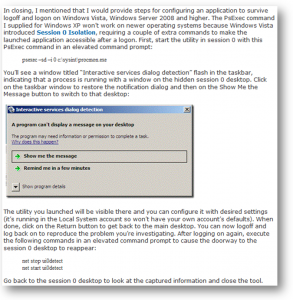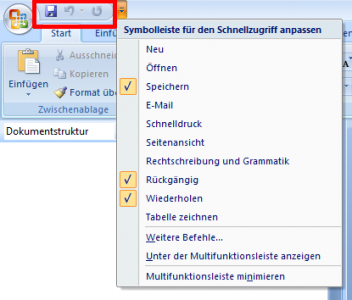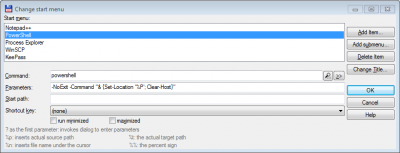New Articles, Tools, Tips and Tricks: Office 2010, RDS/XenApp, Windows, Web
As before this is mainly a condensed and beautified version of my twitter postings. You can get them unfiltered and without delay by following me.
Office 2010
Here is a nice overview of the new Office suite by Mark Wilson. By the way: Although available as 32-bit and 64-bit versions, the 32-bit version is the default and recommended by Microsoft for the time being.
Here is your Group Policy settings reference for Microsoft Office 2010.
The Office 2010 Code Compatibility Inspector checks older Office docs for compatibility with Office 2010, but only one document at a time… Not what I call enterprise-ready.
Terminal Services aka Remote Desktop Services, XenApp and XenDesktop
Interesting white paper from MS (42 pages): Remote Desktop Session Host Capacity Planning in Windows Server 2008 R2. Quotes: “enabling Desktop Composition […] significant impact on resource usage and will affect server capacity negatively”, “200 users on a dual socket 2U server is completely viable for some of the medium to lighter weight scenarios”.
The greatest new feature of XenApp 6? Management by Group Policy. Here are some articles about it:
Group Policy integration in XenApp for 2008 R2
XenApp for 2008 R2 Policies Deep-dive
I started a series on Windows commands in the German O’Reilly blog. The first one is about wmic.
A very good paper by Citrix: How to Really Optimize Windows XP for XenDesktop.
A Citrix blog post shows how to use the ICA client object SDK (ICO) from .NET (C#, to be exact).
XenApp comparative feature matrix: http://www.citrix.com/xenappcomparativematrix.
Citrix Profile Management 3.0 has been released (download via MyCitrix). It features “profile streaming” where files are asynchronously transferred in the background without blocking the logon sequence. This technology has great potential!
My colleague Nicholas Dille explains how to monitor your Citrix license server with EdgeSight 5.3.
Citrix Labs estimates that removing the Citrix Online Plug-in from startup can gain 6% to 11% additional users per server.
Tools
The new App-V SFT View looks really cool: it shows the package’s file system and registry in a virtual directory. Unfortunately it is still very immature and unstable (e.g. copy a .SFT file to a USB drive and then try to eject the drive).
By (re-)setting permissions on profiles the free tool ReProfiler assigns existing user profiles to a new user account, e.g. after joining a domain.
Debugging .NET applications will hopefully become a little bit easier with the WinDbg extension PssCor2 that replaces SOS.dll.
For backing up PCs I’ve come to like the free RSyncBackup. It uses hard links to keep storage requirements low, it is easy to use and very fast.
Windows
How to enable Domain Controller Strict Replication Consistency (important if your forest was originally created on Windows 2000).
Good and relatively deep registry overview in the MS KB: Windows registry information for advanced users. (Did you know that the amount of data you can store in a single registry value is only limited by available memory? – You SHOULD store only 2KB per value, but you CAN store anything – that is surely a reason for registry bloat.)
Here is a blog article explaining how to find out if a .NET assembly (an EXE or a DLL) is compiled for 32-bit, 64-bit or AnyCPU. The tool of choice: CorFlags.
Presentations from Windows Hardware Engineering Conference 2008 are available for download here: http://www.microsoft.com/whdc/winhec/2008/pres.mspx
A fascinating research document: Characterization of Storage Workload Traces from Production Windows Servers.
And another research paper: Migrating server storage to SSDs: analysis of tradeoffs. Quote: “The capacity per dollar of SSDs needs to increase by a factor of 3-3000 for an SSD-based solution to break even with a disk-based solution.”
What’s New in Folder Redirection and User Profiles in Windows 7? Not so much, but read about it anyway.
How to make cmd.exe use UNICODE when generating output instead of the default OEM code page: “cmd /U” (by Raymond Chen)
The new TechNet wikis have some nice content, for example various survival guides:
Hyper-V Survival Guide
PowerShell Survival Guide
Complete list of survival guides
Ever had the problem that one of the many svchost (service host) processes “misbehaves” and you struggle to find out which service actually is the culprit? This is now easier because Process Explorer 12 provides the missing link between services and CPU consumption.
Jose Barreto has written several interesting and detailed articles about specific aspects of PowerShell. Remember, he is a storage guy, so he may do and notice things others do not.
Did you know? Beginning with Vista, the page file need NOT be larger than RAM to accommodate full memory dump in case of blue screen of death (BSOD). See this article for reference.
I found out only recently that Win7 has a (nice) EFS key/encryption management wizard: rekeywiz.exe. This has been missing in XP.
Web
This app looks like Photoshop, but it runs in your browser: pixlr.com. Freaky!
Looking for icons? You might find what you need for free at findicons.com.
Need a multi-resolution icon (16×16 to 256×256) from an existing image? Try converticon.com.







